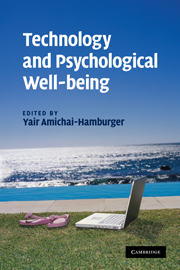Book contents
- Frontmatter
- Contents
- Figures
- Tables
- Contributors
- Acknowledgements
- Introduction
- 1 Communication technology and psychological well-being: Yin, Yang, and the golden mean of media effects
- 2 Internet and well-being
- 3 Information, innovation, and society
- 4 Work-related technological change and psychological well-being
- 5 From ergonomics to hedonomics: trends in human factors and technology
- 6 “Good teleworking”: under what conditions does teleworking enhance employees' well-being?
- 7 Commuting and well-being
- 8 Technology and medicine
- 9 Mothers of invention? The myth-breaking history and planetary promise of women's key roles in subsistence technology
- 10 Technology and well-being: designing the future
- Index
- References
1 - Communication technology and psychological well-being: Yin, Yang, and the golden mean of media effects
Published online by Cambridge University Press: 22 December 2009
- Frontmatter
- Contents
- Figures
- Tables
- Contributors
- Acknowledgements
- Introduction
- 1 Communication technology and psychological well-being: Yin, Yang, and the golden mean of media effects
- 2 Internet and well-being
- 3 Information, innovation, and society
- 4 Work-related technological change and psychological well-being
- 5 From ergonomics to hedonomics: trends in human factors and technology
- 6 “Good teleworking”: under what conditions does teleworking enhance employees' well-being?
- 7 Commuting and well-being
- 8 Technology and medicine
- 9 Mothers of invention? The myth-breaking history and planetary promise of women's key roles in subsistence technology
- 10 Technology and well-being: designing the future
- Index
- References
Summary
The Yin and Yang of ancient Chinese philosophy is the symbol of two primal opposing but complementary forces found in all things in the universe. The Yin and Yang of communication technology could be described as follows: like most technological advances, communication devices improve people's lives immeasurably. Once they use them, people cannot imagine living without them. On the other hand, critics contend that these same electronic communication media – beginning with movies, television, and radio, and today including the Internet, video games, cell phones, PDAs (personal data assistants), and other mobile devices – are turning those of us who spend an inordinate amount of time with them into isolated, narcissistic, anxious, and ultimately unhappy beings. Whether we are technically addicted, or just spend too much of our time communing with digital visual, audio, and text devices, we are thought to be socially fragmented, less able than others who are not as drawn to these technologies to connect in face-to-face interactions. We experience, perhaps, a diminished sense of psychological well-being in comparison to them.
It seems safe to say that each new communication technology could be either a detriment or a benefit to psychological well-being. The Yang of detriments and the Yin of benefits exist as a whole. We could add Aristotle's conception of the golden mean to this equation: There is a midpoint between extremes in which the psychological benefits of communication media are maximized. Below this point, one does not experience the benefits.
- Type
- Chapter
- Information
- Technology and Psychological Well-being , pp. 9 - 33Publisher: Cambridge University PressPrint publication year: 2009
References
- 2
- Cited by

